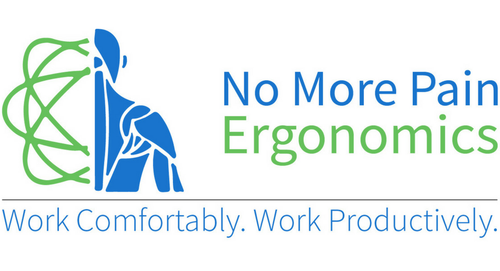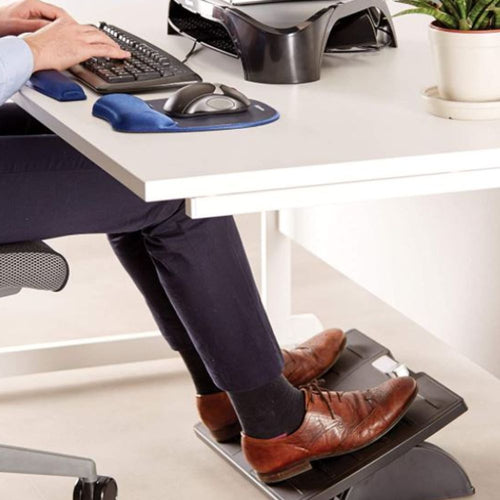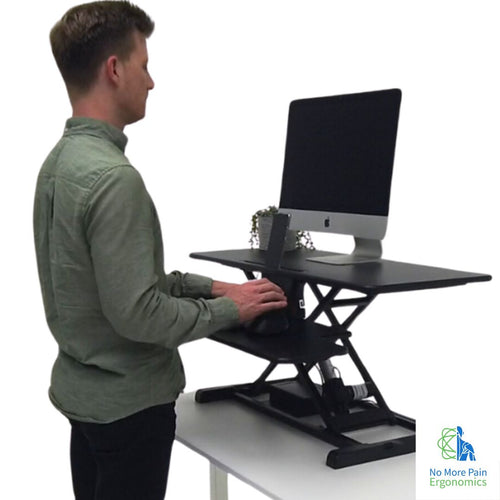
Keyboard
I experience pain in my neck and shoulder when typing
Your keyboard needs to be positioned correctly in order to minimize the risk of developing neck, shoulder, forearm and wrist pain. It should be positioned square on your desk (not off to one side) and the “B” key should be in line with the center of your body. When typing your shoulders should be relaxed and your elbows should be at a 90-100 degree angle. If not, you may need to adjust your chair height in order to achieve this posture.
Be aware of where you position paper copies that you may be data entering. Documents positioned to the side or flat on the desk can cause you to twist your upper body and repetitively have your neck flexed forward or to the side. Always use a document holder to position your documents on. The document holder should be positioned in-line with your body between your keyboard and monitor, so there is no need to twist your neck to look to the side of the monitor. If you are not proficient in touch typing you should consider practicing this skill as touch typists look down at the keyboard less frequently than those with poor typing skills. This may be the root cause for your constant neck pain.

I experience pain in my wrists/ forearms when keying
Position your keyboard approximately 6-7cm away from the edge of the desk, to enable enough desk space in front of the keyboard so that you can rest your forearms on the desk or a wrist support. This may require you to move your monitor further back in order to accommodate the keyboard in the correct position.
The best work posture for typing on a keyboard is to have your wrists in a neutral alignment (aka flat), with the hands in line with the forearms. Try placing the feet on your keyboard down so that it is flat against the desk. This will help to promote a neutral wrist alignment and reduce any wrist extension you may have when typing. If you are unable to get your wrist into a neutral wrist alignment you may require a slim keyboard or an ergonomic keyboard. A slim keyboard is exactly that, a slim height keyboard. It promotes neutral wrist alignment due to its short height. An ergonomic keyboard contains a slight curve in it. This curve helps to eliminate the deviation at the wrist that some people have when they use traditional keyboard.
My work is primarily computer-based with very limited opportunity to alternate tasks
Ideally you should take a break from typing for at least 5 to 10 minutes every 60 minutes. This might mean diverting yourself to other task like moving out of your chair, doing stretches, or filing. If you are the type of person who gets completely engrossed in their work and can’t remember to move regularly, consider downloading a program onto your computer which can act as a timer / reminder to get up and move. Such programs will alert you with a pop-up reminder when you need to stop typing and take a stretch break. There are a heap of free stretch break software on the internet to choose from – try http://www.guardian-eos.com.au/TrialIndex.htm.
Laptops
Laptops are designed for conveniently transporting a computer. They are not designed with ergonomics in mind. Laptops are extremely hazardous from an ergonomics stand point, largely due to their limited adjustments and poor design.

I use a laptop as my primary computer
A good laptop set up is exactly the same as a good desktop computer set up. All the same principles apply. You need to position the screen as you would for a normal PC – i.e. with the top of the screen at or just below eye level, so you can see the screen without bending your neck. Use a laptop docking station or a laptop stand in order to get the monitor at the right height. You will also need a separate full-sized keyboard and mouse as you can not use the ones built into the laptop once it is on the laptop stand or dock.




















← Older Post Newer Post →
0 comments
Get in Touch
Still have a question or simply want to discuss what ergonomic products are best suited? Get in touch, our expert team is available to provide free advice and support.